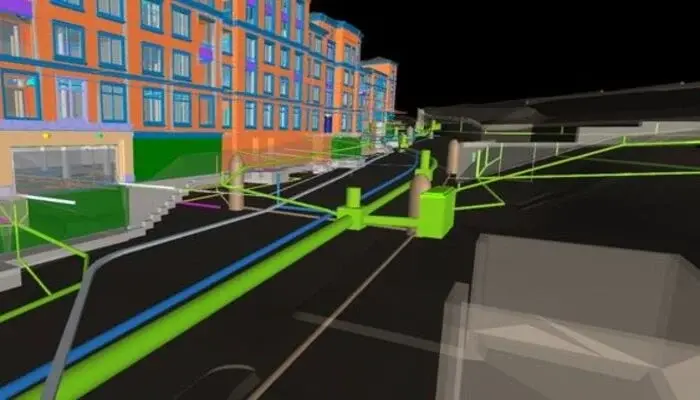
Building Information Modeling (BIM) is a significant contributor to upgrading the methods of design and execution through effective ways of visualization and management. The combination of BIM and quantity surveyors is preferred over traditional ways because it provides a more collaborative and effective approach to construction projects. As technology continues to evolve, quantity surveyors are expected to adapt to new-age tools and methodologies like automated measurements and artificial intelligence-driven cost predictions.
According to CIRIA, emerging technologies like BIM will continue to reshape quantity surveying practices, but the question is — are quantity surveyors ready for BIM? To leverage the advances of BIM, the gap in software adoption within the industry needs to be filled in order to land quantity surveyor jobs and opportunities.
Why Is BIM Redefining the Future of Quantity Surveying?
BIM is redefining cost management and project efficiency for quantity surveyors. Whether you’re working on residential towers, commercial spaces, or large-scale infrastructure, BIM empowers quantity surveyors to extract precise quantities, forecast budgets with higher accuracy, and track real-time cost variations. It minimizes measurement errors, supports 5D simulations for cost planning, and strengthens collaboration with architects and contractors. In fact, BIM is shifting the quantity surveyor's role from a traditional estimator to a strategic advisor. Statista reports that the global smart building market is estimated to have a CAGR of 7.27% through 2029, generating a revenue of approximately $35 billion.
5 Applications for BIM in Quantity Surveying

Quantity surveying is an essential discipline within the construction industry, responsible for managing costs, contracts, and procurement. Let’s get into the core applications of BIM in the field of quantity surveying.
1. Automated Quantity Takeoff & Estimation
BIM enables automated extraction of quantities directly from 3D models, saving time and minimizing human error. Quantity surveyors can generate accurate BOQs, apply real-time pricing, and track cost implications for design changes, ensuring greater precision in project budgeting.
2. 5D Cost Planning & Simulation
5D BIM introduces the time and cost dimensions into the model. This lets quantity surveyors simulate the financial impact of design decisions over the project timeline. From material costs to labor forecasting, quantity surveyors can perform scenario-based planning to optimize resource allocation.
3. Clash Detection & Cost Risk Analysis
Using BIM’s clash detection capabilities, quantity surveyors can identify potential issues and factor in associated cost risks. This prevents costly rework and allows for better contingency planning, helping projects stay within budget and schedule.
4. Tender Documentation & Procurement Management
With model-based data, quantity surveyors can prepare more accurate and detailed tender documents. BIM streamlines the comparison of supplier bids, improves transparency, and supports procurement strategies that align with project goals and timelines.
5. Lifecycle Cost Management & Facilities Integration
Beyond initial construction costs, BIM supports lifecycle cost assessments for building operation and maintenance. Quantity surveyors can link models to asset databases, enabling cost forecasting for repairs, energy use, and refurbishment over the building’s lifespan.
5 Benefits of BIM for Quantity Surveying

The benefits of BIM are numerous when it comes to the infrastructure and construction industry as a whole, but the ones that are especially useful for quantity surveyors include the following:
1. Accuracy in Quantity Takeoffs
Appropriate cost estimation is essential to the success of any construction project. The direct quantity extraction features of BIM can generate quantity takeoffs for structural components. This allows quantity surveyors to estimate the accurate cost of materials, minimising the cost overruns during construction.
2. Improved Visualization
The use of BIM in quantity surveying allows the creation of detailed 3D models and simulations of complex infrastructure projects. This enables quantity surveyors, clients, and everyone involved to visualize the structure from different angles, avoid conflicts, improve transparency, and speed up decision-making during the planning and approval stages. If they identify potential errors, they can make changes and see the impact on the structure in real-time.
3. Increased Efficiency
BIM software for quantity surveyors can increase productivity and efficiency by automating many tasks that were previously done manually. It also enables them to reuse design components and data from previous projects, reducing the repetitive work required.
4. Improved Collaboration and Coordination
A significant impact of BIM on quantity surveyors has been enhanced collaboration and coordination among various disciplines in real time. It accurately estimates and forecasts project costs in a shared environment by identifying potential issues and conflicts. This reduces time-intensive reworks and eases the execution process.
5. Smart Decision Making
BIM allows data-embedding into every element of a 3D model. Quantity surveyors can use this data to evaluate environmental impacts and simulate performance under various conditions. These insights support more informed and resilient infrastructure planning throughout the project lifecycle.
Integrated BIM Workflows for Quantity Surveying
From initial design to post-construction evaluation, quantity surveyors are involved in multiple phases that demand coordination and precision. Whether it's a commercial building, residential complex, or infrastructure project, each involves a vast network of materials, labor inputs, and evolving budget constraints. That’s where integrated BIM workflows come in handy. Rather than relying on disconnected spreadsheets and manual takeoffs, quantity surveyors can operate within a digital environment that links design models, cost databases, and procurement schedules. This approach allows for real-time updates, accurate quantity extraction, and smarter cost forecasting.
3 Popular BIM Software for Quantity Surveyors

Software provide a platform to execute BIM processes. It becomes the medium through which BIM can be understood and applied. Here are three of the most-used BIM software programs for quantity surveyors.
1. Revit
While Revit's core strength lies in 3D modeling and design, it also offers powerful features for cost estimation and quantity takeoffs. By generating precise material schedules directly from models, Revit helps quantity surveyors extract accurate data for budgeting and planning. Its parametric design engine ensures that any changes in the model automatically update associated quantities, enhancing both efficiency and accuracy.
2. Cubit Pro
Cubit Pro, created by Buildsoft, is a powerful software solution among quantity surveyors, especially those focused on takeoffs and cost estimation. Preferred for its intuitive interface and advanced estimating capabilities, Cubit Pro simplifies and speeds up the entire estimation workflow.
3. Cost X
CostX, developed by Exactal, is another favorite tool among quantity surveyors due to its powerful takeoff and estimating functionalities. Renowned for its integration with 3D/BIM technology, CostX enables users to perform cost analysis directly from 3D models, significantly improving precision and streamlining the cost management process.
Also Explore 10 Essential Softwares Used by Quantity Surveyors
3 Career Opportunities for BIM-Skilled Quantity Surveyors
The future of work for BIM-skilled quantity surveyors is only expected to become more lucrative. Let’s explore a few of the career paths one can explore after specializing in BIM for quantity surveyors.
1. 5D BIM Commercial Manager
With BIM’s integration of cost data (5D BIM), quantity surveyors can specialize as commercial managers who analyze and control financial aspects of a project throughout the tendering and construction phases. These professionals work closely with architects and engineers to develop accurate cost forecasts and procurement, perform real-time cost analysis, manage contracts, and track budget deviations directly from the BIM model.
2. Principal or Lead Quantity Surveyor
This senior-level position is often responsible for guiding large-scale projects or managing several project teams. This role combines project oversight with strategic planning and involves collaborating with stakeholders at all levels. As a lead quantity surveyor, you’ll maximize profitability, align project goals with company objectives, and ensure adherence to industry standards.
3. Project Controls & Risk Analyst
BIM-trained quantity surveyors are increasingly taking roles in project controls, using BIM-integrated data to assess risk, simulate scenarios, and advise on cost implications across the project lifecycle. Their insights are valuable for minimizing change orders, controlling overruns, and enhancing financial transparency.
3 Best BIM Courses for Quantity Surveyors
1. BIM Professional Course for Civil Engineers by Novatr
Duration: 7 months
Fee: $2,500
The program begins with the fundamentals of BIM and gradually progresses into modeling components, creating families, and working with concrete and steel structures. This course equips quantity surveyors with the technical skills to interpret and extract detailed data from BIM models for accurate quantity takeoffs and cost estimation. As part of the curriculum, it covers advanced topics like precast elements, reinforcement detailing, scheduling, annotations, documentation, and presentation of BIM models, which support the preparation of bills of quantities and cost reports. Participants gain practical insights into project management, collaboration, and communication with stakeholders through hands-on capstone projects and receive placement assistance.
2. Certificate in Quantity Surveying Practice by RICS Online Academy
Duration: 8 months
Fee: N/A
The Royal Institution of Chartered Surveyors (RICS) provides an online course to equip quantity surveyors with a solid foundation in the fundamental principles. It provides industry-aligned BIM training for quantity surveyors that reflects current best practices and explores essential topics. It also grants access to RICS resources, including case studies and expert-led webinars.
3. EdX Project Management for Construction by Columbia University
Duration: 4 months
Fee: N/A
Available on EdX from Columbia University, this course is a valuable resource for quantity surveyors aiming to navigate the complexities of large-scale projects and master the entire project lifecycle. The curriculum covers scheduling, resource planning, and managing project risks. It is self-paced, has interactive discussions, practical assignments, and peer-based feedback.
In Conclusion
With the construction industry becoming more and more dependent on emerging technologies, its adoption has become a must for most organizations. At this point, it only makes sense for quantity surveyors to take up a course that can help them handle projects both in number and complexity.
If you're looking to stay relevant as a quantity surveyor or want to improve your skills with hands-on learning, we suggest you consider the BIM Professional Course for Civil Engineers by Novatr. It is one of the most comprehensive programs that provides detailed insights into BIM processes using 12+ software. The course is taught by expert-led professionals who bring their expertise and knowledge to the live classes. Participants also learn how to implement their skills through capstone projects. Novatr also helps students with portfolio creation, resume building, and job placements in their preferred companies.
Visit our Resources Page to learn about the latest design updates and trends doing the rounds in the construction space.
Was this content helpful to you



.jpg)




-1.png)

-1.png)
